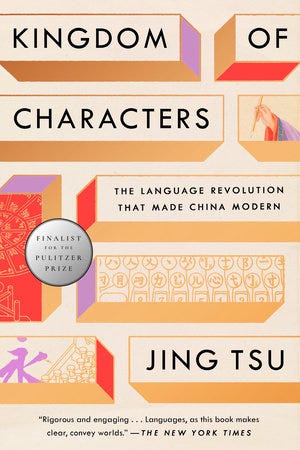'Kingdom of Characters': Linguistic history
Jing Tsu takes a deep dive into the written Chinese language.
This post contains an affiliate link or links. If you use a link to buy a book, I may earn a small commission. You can find all the books that have been featured in this newsletter in my Bookshop store.
Mandarin was my first language. But when I started preschool, I learned English and my parents began mixing more English into our household conversations, so my ability to speak and understand Mandarin has stayed more or less at a preschooler’s level. I learned to recognize and write a few Chinese characters — my name, the numbers 1 through 10 and a few others — but that was it.
Still, I was exposed to written Chinese regularly. My dad was a librarian specializing in East Asian studies, so books in Chinese were always lying around the house. My mom subscribed by mail to newspapers in Chinese; later, with the advent of the internet, she got her news fix on Chinese-language websites.
So it never occurred to me until reading Jing Tsu’s “Kingdom of Characters: The Language Revolution That Made China Modern,” one of this year’s Pulitzer Prize finalists, how extraordinarily difficult it was to adapt written Chinese to communications technology. Tsu, a cultural historian at Yale, has written a lively examination of how China met a unique linguistic challenge that threatened to relegate it to the status of global also-ran.
China is home to more than 300 languages and dialects, not all of which are Chinese. Many Americans are familiar with Mandarin, the official national dialect, and Cantonese, the dialect that early Chinese immigrants brought to the United States. Mandarin, Cantonese and other Chinese dialects can differ enough to be mutually unintelligible. Then there are the variants. My parents grew up speaking what is commonly known as Taiwanese; technically, it’s a version of Hokkien, which is itself a variant of the Min dialect of southeastern China.
This Tower of Babel was problematic, as Tsu notes while introducing us to Wang Zhao (no known relation to me), an imperial official who fell out of favor for daring to suggest reforms as the Chinese empire approached the 20th century. Among the reforms he sought: simplifying written Chinese to increase China’s low literacy rate.
While working on his alphabet, Wang never strayed from the beliefs he had shared with the emperor back in 1898: China was losing its power because language was failing its people. Their low literacy and divided dialects impeded China’s ability to govern, negotiate with foreign powers, and keep pace with the outside world. China’s success as a nation and an international power hinged on the single issue of an accessible spoken and written language.
Tsu details this conundrum through four case studies: typewriters, telegraphy, library classification systems and Romanization, the process of transcribing other languages into the Roman alphabet that the Western world uses.
Imagine, say, a typewriter that had each key devoted to a single Chinese character; you’d need a keyboard with thousands of keys. Or imagine trying to wrestle all those characters into the dots and dashes of Morse code to send a telegram. Now imagine classifying books in a library when your language can’t be ordered alphabetically. And how exactly does one map thousands of characters and a range of tones onto 26 atonal letters?
One solution, Tsu explains, was to reduce the number of Chinese characters that typewriters and later technology would rely on. While this might seem drastic, Chinese is littered with rarely used or obsolete characters, just as English has rarely used or obsolete words. (When was the last time you said or wrote “goodwife”?) Another solution was to simplify characters by streamlining the number of strokes needed to write the more complicated ones. Language reformers also broke characters into standard components for easier classification — at one point Tsu describes how one uses a Chinese dictionary and, having seen the process myself, I’d say she nails it.
The Romanization chapter is my favorite, as I have clear memories of my father patiently explaining the differences between the Wade-Giles system of Romanization, which rendered China’s capital city as Peking, and Pinyin, which turned the capital into Beijing. (The transition from one to the other was a big deal for Dad and his colleagues in East Asian studies.) These days, I wonder what my father would say if he could see me parsing Pinyin while doing Mandarin lessons on Duolingo, the language learning app. I wonder what my mother would say if she could see her family texting one another in Chinese.
“Kingdom of Characters” is a fascinating read that proves how much words can matter.




Really enjoyed this review, especially how you wove in bits of your personal history and what you learned of the history of Chinese. I’ve put the book on my list.